
In this article, the secrets of setting up a standard discus aquarium tank, as well as, designing a proper discus aquarium aquascape will be revealed. In setting up a standard aquarium, acquiring the right tank is very important.
Table of Contents
- Discus Tank Requirements
- Material Used
- 8 Discus Tank Setup Ideas and Aquascaping Designs
- [1] – Iwagumi (Japanese style) Aquarium Design Idea
- [2] – Dutch Aquarium Design Idea
- [3] – Natural Aquarium Design Idea
- [4] – Taiwanese Style Design Idea
- [5] – Jungle Style Aquarium Design Idea
- [6] – Walstad Method Design Idea
- [7] – Biotope Style Aquarium Design Idea
- [8] – Elegant Clean Aquascape Design Idea
- What Is A Discus Quarantine Tank Size?
- Conclusion
Discus Tank Requirements
For you to set up a standard Discus tank, you need to know all the requirements or guidelines. These requirements or guidelines are determined by the type of aquarium and some of such details are materials used, the heights, and the sizes of the aquarium; all these make up the Discus aquarium design square.
Below are some types of discus aquarium and its requirements.
Material Used
Aquarium tanks are classified according to the materials used, which are glass tanks, acrylic tanks, plastic, and wood tank, etc. The glass, acrylic, and plywood tank will be discussed below:
Glass Tank
A glass tank is widely used because of its high watertight and scratch-resistant properties.

It is built with five pieces of glass linked with inert-silicon sealant. The glass tank is often contrasted against the acrylic aquarium when the cost is considered.
The glass tank is divided into the regular plate glass and the low-iron glass, but the most common is the regular plate glass.
Listed below are some characteristics of a glass tank:
- High scratch resistance.
- Scratches are permanent if obtained.
- The index of refraction is higher.
- Support in edges is required for it to stand.
- Cheaper per gallon
- Very Fragile
- Weighty and heavy
Acrylic Tank
The acrylic tank has been the major rival to the glass tank over the years, but the acrylic tank is enhanced with the UV stabilization invention.
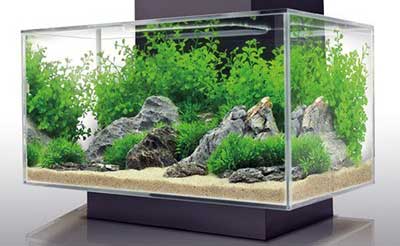
Some of the characteristics of acrylic tanks are:
- Very easy to scratch
- It can be polished
- Temperature insulation
- Lighter and weighs less than glass
- It can form unique shapes, like a hexagon
- Difficult to break
- The index of refraction is low
- Supports required for both the edges and base
- More expensive per gallon.
Plywood Tank
A plywood tank is also a good option. It can be made at home, with materials that are easy to acquire.

But, it very important to know that it is weak against water, so it must be properly waterproofed using a liquid rubber geotextile material. Waterproofing is the most important part of a wood aquarium tank design.
The liquid rubber Canada waterproof sealant is highly recommended because it is odorless, non-toxic, and has no solvents. It is advertised to have a 100% waterproofing strength.
Here are some characteristics of a plywood tank:
- Can be heavy to move around.
- Due to the use of numerous materials, they can become expensive and tedious to build.
Height
You can either use a low or a high tank. The surface area of the high tank is smaller, while that of the smaller tank is larger. The low and high tank has a short vertical profile and a taller vertical profile respectively.
The discus fish enjoys free-flowing swimming, and since the low tank has a wider surface area, it is recommended as a better option.
Size
How Big Of A Tank Do I Need For Discus?
The smallest tank size of capacity ranging between 50-60 gallons, provides the best environment for your Discus. Contrary to popular view, a larger size tank is much easier to clean than a smaller size tank.
Below are some helpful tips you should consider before choosing the size of your Discus aquarium tank:
- The larger your tank, the easier it is to stabilize the chemical composition of the water. When there is a small chemical change, the water quality in a small tank changes rapidly than a larger tank due to the quantity of water it contains. Discus fish are very sensitive, so you should consider a larger tank size.
- Changing water is easier in larger tanks. You will require just a bucket more when doing a regular temporary water change in a large tank.
- More fishes can be added to a large tank.
- The volume and shape of a tank play a key role in the number of fishes it can contain.
8 Discus Tank Setup Ideas and Aquascaping Designs
The focus of most aquarists always shifts from the fish (animals) to the visual contents in their tank. This happens, because, when the environment is good, the fish and other aquatic animals in the tank are also good.
Designing the tanks requires artistic skills to bring beauty to the tank. A few ideas on discus tank set up are discussed below;
[1] – Iwagumi (Japanese style) Aquarium Design Idea
This method of designing an aquarium was created by Takashi Amano, who is regarded as the father of modern aquascaping.
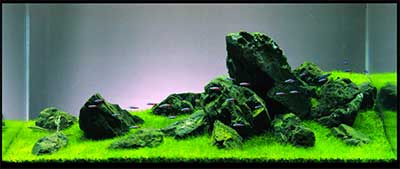
The primary hardscape used in this design is odd-numbered rocks in different sizes. Small plants are used to harmonize and balance the visual effects.
The Iwagumi design aims at recreating a particular natural landscape just like an underwater mountainside in your aquarium. The plants are used to mimic bushes and trees along the hilltop, and it acts as a backdrop in highlighting the rock features.
Iwagumi Aquarium Set up
- Set up the sand bed, by pouring sandstone and granite on the base of the tank.
- Place the rocks of different sizes on the granite.
- Add the plants around the rocks.
- Cover the plants with a cloth and add the required amount of water to the tank.
Examples of Iwagumi aquarium idea are:
- Iwagumi 5-Gallon or 10-Gallon Aquascape
- Simple Iwagumi Aquascape for Big Tanks
- Mountain Iwagumi Aquascape Diorama
- Hilltop Iwagumi Aquascape
[2] – Dutch Aquarium Design Idea
This method of design makes use of bigger plants of different kinds arranged in terraces or rows to add color to the tank.
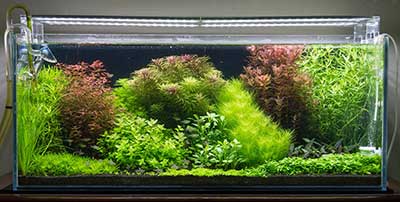
The substrate sometimes is totally hidden under a layer of low growing mosses or small plants.
This aquascaping also uses little hardscaping but more of substrate and plants to create visual effects in your tank. After several months of shaping and pruning your plant’s growth, your tank will become beautiful.
Dutch Aquarium Set up
- Prepare the base by pouring the power to grow and add bacter on top.
- Pour the floredepot on top of the bacter and add the initial stick.
- Pour the soil Amazonia on the top to create a base for the rasamala tree trunk.
- Place the rasamala tree trunk on the base and pour more soil Amazonia on around it.
- Add water to soak the substrates.
- Then, add the various plant species around the rasamala and pour the required amount of water to fill the tank.
Examples of Dutch aquarium idea are;
- Aquascape a Dutch Style Tank
- Large Dutch Aquascape
[3] – Natural Aquarium Design Idea
The Natural aquarium design is done to replicate the lake bottom or riverbed habitat, with the hardscape and plants being arranged to look natural.
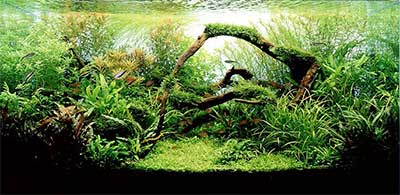
Natural Aquarium Set up
- Create a small compartment on the base of the tank using stones (mini landscape rock).
- Pour tropical soil on the enclosed compartment and some sand on the other side of the compartment.
- Place river wood on the tropical soil.
- Attach the various plants on the river wood and around it.
- Add the required quantity of water to fill the tank.
Examples of natural aquarium ideas are:
- Densely Planted Natural Aquascape
- Lakebottom Aquascape with Sandy Substrate
- Small Meadow Aquascape
- Natural Waterfall and River Aquascapes
- Natural Design for a 5-Gallon Aquascape
- 10-Gallon Natural Aquascape
- 75-Gallon Natural Aquascape with Low Lighting
- Amazon Natural Aquascape
- Natural Island Aquascape
[4] – Taiwanese Style Design Idea
This design method is not very popular today, because it fell out of style when pitched against Nature Aquarium and Iwagumi designs. It is employed mostly in regions with a high terrace of varying depth.
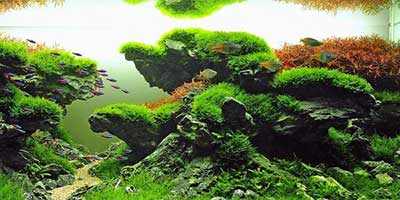
Taiwanese Aquarium Set up
- Place pebbles on the base of the tank close to the front corner.
- Spread pea gravel on the base, with more on the opposite part of the pebbles.
- Pour in the grit (smaller pea gravel) to add to the pea gravel.
- Add fine sand
- Add the plants, empty shells, and bogwood branches.
[5] – Jungle Style Aquarium Design Idea
This design focuses on replicating a jungle, and it is usually nicer in bigger tanks.
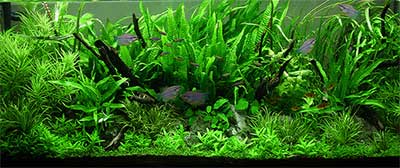
Jungle Aquarium Set up
- Evenly spread the substrate on the base of the tank, about 20 liters of TMC NutraSoil
- Place the Sumatra wood in good positions.
- Start placing the plants on the wood.
- Spray the Java fern moist on the plants
- Add water to the tank.
[6] – Walstad Method Design Idea
This method was designed by a world-renowned ecologist, Diana Walstad. She created a natural planted aquarium, which some acclaims as one of the best aquarium design.
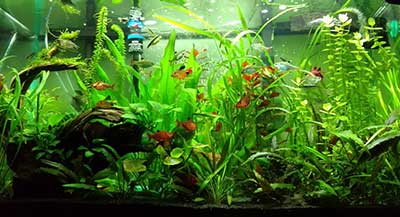
Walstad Aquarium Set up
- Prepare the substrate and pour them on the base of the tank.
- Wet the substrate.
- Add the plants.
- Add the required amount of water.
[7] – Biotope Style Aquarium Design Idea
The biotope design infuses African culture into aquarium, just like the Dutch and Iwugami.
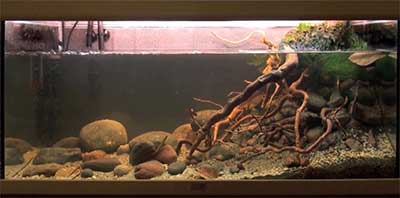
Biotope Aquarium Set up
- Prepare the substrate and soak the wood.
- Pour in your nutribase in those areas you want to place heavy plant growth.
- Pour Senegal sand on the nutribase.
- Properly place the woods in position.
- Add half full and start putting the plants.
- Fill completely with water.
[8] – Elegant Clean Aquascape Design Idea
This is my favorite Discus aquarium setup design, it is even very easy to set up and cost-effective for any Discus keeper.

Clean Aquascaping Design Set up
- Prepare the sand substrate
- Prepare your driftwood or your stones.
- Put the sand in the simple design you like
- Add the driftwood/stones on top of it on the preferred location.
- Fill the tank with water and enjoy.
What Is A Discus Quarantine Tank Size?
The normal quarantine size that will be perfect for a Discus fish is about 30 gallons, especially when they are at the juvenile stage. The bigger space, the better for the Discus fish.
Conclusion
I sincerely hope you have gotten great ideas on the discus aquarium tank setup and the required steps to construct your own aquascaped tank! There is no fixed or streamlined way of designing your tank, but you can modify an idea, by adding your own unique creativity to set up your Discus tank.
The idea of aquascaping is to creatively use plants to highlight the tank hardscape, and to maintain the best appearance and growth of the plant.

